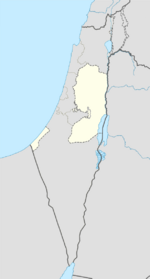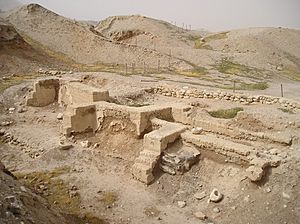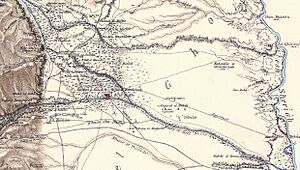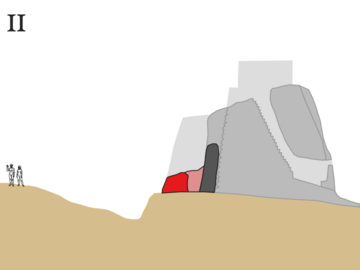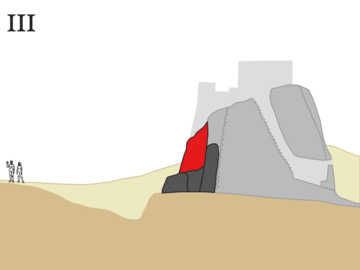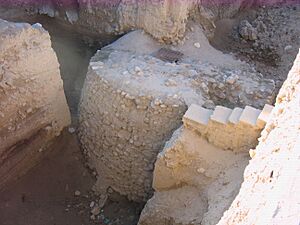Tell es-Sultan facts for kids
| Lua error in Module:Wikidata at line 70: attempt to index field 'wikibase' (a nil value).
Tell es-Sultan
|
|
| Location | Jericho, West Bank Palestine |
|---|---|
| Region | Levant |
| Coordinates | 31°52′16″N 35°26′38″E / 31.87111°N 35.44389°E |
| Type | Settlement |
| History | |
| Founded | c. 10,000 BCE |
| Abandoned | c. 900 BCE |
| Cultures | Natufian (Epipaleolithic), Jericho IX (Pottery Neolithic), Canaanite (Bronze Age) |
| Official name | Ancient Jericho/Tell es-Sultan |
| Type | Cultural |
| Criteria | iii, iv |
| Designated | 2023 |
| Reference no. | 1687 |
| Region | Asia-Pacific |
Tell es-Sultan (Arabic: تل السلطان, meaning Sultan's Hill), also known as Ancient Jericho, is a very old archaeological site. It is located in the city of Jericho in Palestine. This site is famous for having the remains of what might be the oldest fortified city in the world.
Tell es-Sultan is right next to the Ein as-Sultan refugee camp. It's about two kilometers north of the center of Jericho. People have lived on this "tell" (which is a mound made of layers of old settlements) since about 10,000 BCE. This makes Jericho one of the oldest cities where people have lived without stopping. The site is super important for understanding the history of archaeology in the Levant region.
A person named Charles Warren first figured out this was the site of ancient Jericho in 1868. He noticed it was close to a big spring called Ein es-Sultan. This spring had been thought to be the one mentioned in the Bible, where the prophet Elisha performed a miracle.
Contents
History of Ancient Jericho
Early Stone Age People (Epipalaeolithic)
Around 9600 BCE, the weather changed. It became warmer after a very cold period. This warmer climate allowed groups of people from the Natufian culture to stay in one place longer. Eventually, they started living there all year round. The first permanent homes at Tell es-Sultan were built between 10,000 and 9000 BCE. This was even before people started farming! The nearby Ein as-Sultan spring made Tell es-Sultan a great camping spot for these hunter-gatherers. They left behind small, crescent-shaped stone tools.
First Farming Villages (Pre-Pottery Neolithic A)
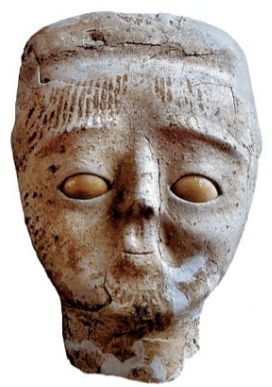
The next period at Tell es-Sultan was called Pre-Pottery Neolithic A (PPNA), from about 8500 to 7500 BCE. During this time, one of the world's first big "proto-cities" (early cities) appeared. As the world got warmer, a new way of life began, based on farming and living in one place. Archaeologists call this the PPNA era.
The PPNA town was quite large, covering about 40,000 square meters. It had round houses made of mud bricks. These bricks were dried in the sun and held together with mud. Each house was about 5 meters across and had a roof made of branches covered with mud. People cooked inside and outside their homes.
Historians are still discussing how many people lived in Jericho during the PPNA period. Estimates range from 200-300 to as many as 2000-3000 people. We know they grew crops like wheat, barley, and peas. They also hunted wild animals.
This town was surrounded by a huge stone defensive wall. It was over 3.6 meters high and 1.8 meters wide at the bottom. Inside the wall, there was a stone tower in the middle of the west side. This tower was the tallest building in the world for a long time! The wall and tower were built around 8000 BCE. Building them would have taken 100 men more than 100 days. This shows that the people had a good way of organizing their work.
Later Farming Villages (Pre-Pottery Neolithic B)
After a few centuries, the first settlement was left empty. Then, a new settlement, called Pre-Pottery Neolithic B (PPNB), was built around 6800 BCE. This new group of people might have joined with the original inhabitants. From this time, archaeologists found ten plastered human skulls. These skulls were painted to look like real faces. People might have kept them in their homes while the bodies were buried.
The buildings in the PPNB period were rectangular, made of mud bricks on stone foundations. The mud bricks had deep thumbprints to help them stick together. Homes often had several rooms around a central courtyard. Some rooms had shiny red or pink floors made of lime.
Archaeologist Kathleen Kenyon thought one building might have been a shrine. It had a special spot in the wall where a stone pillar might have stood.
People were buried under the floors of their homes or in old, abandoned buildings. Sometimes, many people were buried together. Some skeletons were not complete, which might mean the bodies were left out for a while before burial. One special discovery was a group of seven human skulls. Their jaws were removed, and their faces were covered with plaster. Shells were used for eyes.
Other items found include:
- Flint tools like arrowheads and knives.
- Tools for grinding grain.
- Bowls carved from soft stone.
- Stone weights for spinning thread.
- Figures of people and animals made from plaster and clay.
- Beads made from shells and green malachite.
Bronze Age Cities
Many settlements followed from 4500 BCE onwards. The biggest one was built in the Early Bronze Age, around 2600 BCE. Tell es-Sultan was often lived in, destroyed, and then rebuilt. This is why archaeologists find many layers of destruction.
The city was continuously lived in from the Early Bronze Age into the Middle Bronze Age. It seems the city was destroyed and abandoned around 2000/1950 BCE. But it was rebuilt and became largest between 1700 and 1550 BCE. At this time, it was an important city in the Canaan region. It had strong defensive walls with rectangular towers. There was also a large cemetery with underground burial chambers. Some of the fancy items found in these tombs might show that local kings were emerging.
The city was destroyed again in the 16th century BCE. After this, people lived there again during the Late Bronze Age (1550–1200 BC). The old Middle Bronze Age city wall was fixed up by adding a mud-brick wall on top.
Iron Age Settlement
People started living in Tell es-Sultan again around the 11th century BCE. The town was fortified again in the 10th century. Not much is left of this new city, just a "four-room house" on the eastern slope. By the 7th century, Jericho had become a big town. However, this settlement was destroyed when the Babylonians conquered Judah in the early 6th century BCE.
When the Tell Was Left Empty
Jericho was destroyed by the Babylonians in 587/586 BCE. This happened because Judah rebelled against Babylon. The city was rebuilt later, during the Persian period, after the Jewish people were freed from Babylon. There are very few remains from this time. The site was abandoned as a main settlement not long after this period.
Archaeological Discoveries
The first digs around Ain es-Sultan (meaning "Sultan's spring") were done by Charles Warren in 1868. He was working for the Palestine Exploration Fund. Warren dug up nine mounds near the spring. During one dig, his workers dug right through the mud bricks of a wall without realizing what it was!
The spring had been identified in 1838 as the place of Elisha's miracle. Based on this, Warren suggested the mounds were the site of Ancient Jericho. But he didn't have enough money for a full excavation.
Later, Ernst Sellin and Carl Watzinger dug at Tell es-Sultan between 1907 and 1909, and again in 1911. They found the remains of two walls. At first, they thought these walls supported the biblical story of the Battle of Jericho. But they later changed their minds. They dated their finds to the Middle Bronze Age (1950–1550 BCE).
John Garstang excavated the site again from 1930 to 1936. He also suggested that the upper wall remains were the one described in the Bible, dating to around 1400 BCE.
More detailed investigations were done by Kathleen Kenyon from 1952 to 1958. She used more modern techniques. Her digs uncovered a tower and a wall. Kenyon found evidence that both were much older than previously thought, dating back to the Neolithic period. They were part of an early "proto-city." Her excavations found seventeen walls from the early Bronze Age. She believed some might have been destroyed by earthquakes. The last of these walls was built quickly, suggesting the settlement was destroyed by invaders. Another wall was built by a more advanced culture in the Middle Bronze Age. It had a steep plastered slope leading up to mud bricks on top.
More recently, Lorenzo Nigro and Nicolo Marchetti led excavations from 1997 to 2000. Since 2009, an Italian-Palestinian team has continued the work. They have uncovered several important structures from the Bronze Age city. These include palaces, the south-east gate (called Jerusalem Gate), and parts of the ancient city walls.
Ancient Walls of Jericho
The city wall from the PPNA period was built for defense or to protect against floods. The wall was very thick (about 1.5 to 2 meters) and tall (3.7 to 5.2 meters). This suggests it was built for defense. It is thought to date back to about 8000 BCE. If it was an "urban fortification," the Wall of Jericho is the oldest city wall ever found by archaeologists! Around the wall was a ditch, 8.2 meters wide and 2.7 meters deep. This ditch was cut into solid rock and went around the town for about 600 meters. Kenyon said that digging this ditch out of solid rock must have been "tremendous" work.
- How the Walls Were Built
The Tower of Jericho
The Tower of Jericho is an 8.5-meter-tall stone structure. It was built in the Pre-Pottery Neolithic A period, around 8000 BCE. It is one of the very first stone monuments ever made by humans. The tower is shaped like a cone. It is almost 9 meters wide at the bottom and gets narrower to 7 meters at the top. Its walls are about 1.5 meters thick. Inside, there is a staircase with 22 stone steps.
Timeline of the Near East


